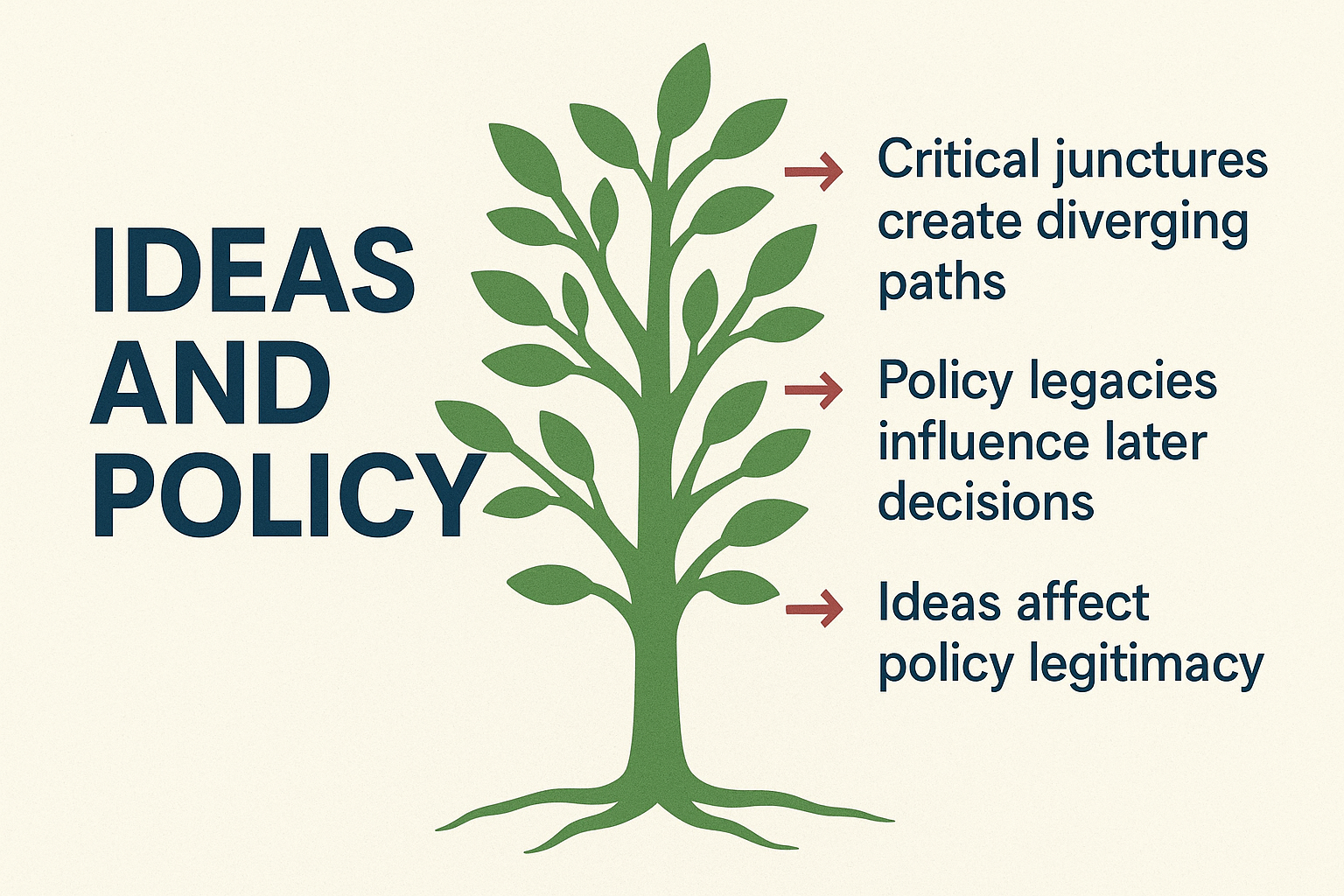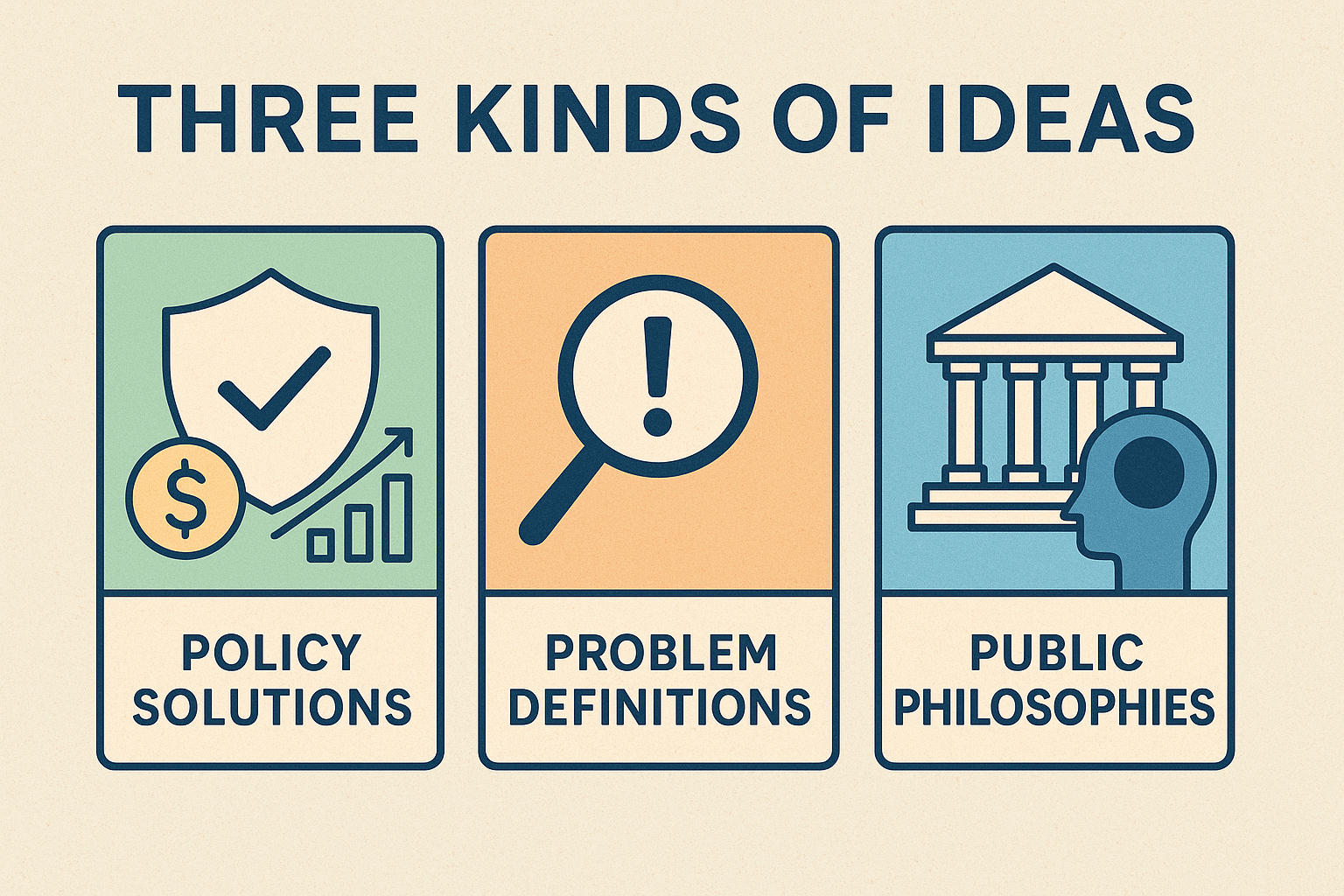The article “Three Kinds of Ideas” explores how different levels of ideas—policy solutions, problem definitions, and public philosophies—shape the policymaking process and political change. Policy ideas like Keynesianism provide concrete solutions to given problems, while problem definitions frame what issues governments prioritize. At the broadest level, public philosophies and zeitgeist guide the underlying values and assumptions of a society. Drawing on scholars like Peter Hall, John Kingdon, and historical institutionalists, the article explains how ideas evolve, gain legitimacy, and influence outcomes in politics. Understanding these three kinds of ideas helps reveal why certain policies succeed, how political debates form, and how historical legacies shape future decisions.
Three Kinds of Ideas
Although scholars often talk about “ideas” as if they were one concept, there are at least three different levels of ideas that are relevant to understanding the policy process, In the narrowest conception, ideas can be policy solutions, Keynesianism is perhaps the most famous policy idea; other obvious examples are smaller class sizes or broken-windows policing.
The implicit assumption here is that the problem is given (business cycle is too volatile, test scores are too low, crime is too high), the objectives are given (stabilizing the business cycle, raising test scores, lowering crime), and the idea provides the means for solving the problem and accomplishing those objectives.
But as many scholars have pointed out, problems and objectives are not preestablished (Rein and Schon 1977; Schon and Rein 1994). To understand this process, we also need to understand the roles ideas can play as problem definitions. A problem definition is a particular way of understanding a complex reality.
Homelessness, for example, can be seen as the product of a housing shortage, high unemployment, or a lack of individual gumption. The way a problem is framed has significant implications for the types of policy solutions that will seer desirable, and hence much of political argument is fought at the level of problem definition.
Finally, ideas can function as public philosophies or as zeitgeist. These are broader ideas that cut across substantive areas. A public philosophy is an idea about how to understand the purpose of government or public policy in light of a certain set of assumptions about the society and the market (Heclo 1986).
That the local government is more attuned to the needs of the people than the federal government is one such public philosophy. A related idea is the zeitgeist, which is a set of assumptions that are widely shared and not open to criticism in a particular historical moment. The zeitgeist includes a disparate set of cultural, social, and economic assumptions, which might not be as closely related to the purpose of government as a public philosophy.
Keynesian economics in the years between the end of World War II and the early 1970s was an idea that had reached the level of the zeitgeist; the idea of holding people accountable has a similar status today. When public philosophies are in open contest, as is usually the case, neither has the status of zeitgeist, but when one emerges as overwhelmingly dominant (as in the New Deal), public philosophies can for a short time become the zeitgeist. These untouchable assumptions obviously have a broad influence on politics (and society) for the period in which they reign.
Dividing ideas into these three analytic categories allows us to ask questions about how each kind of idea works in politics and to think about interactions among the different levels of ideas. We will consider each of the types in turn and then together.
Ideas as Policy Solutions
Policy solutions are both the narrowest conceptualization of the role that ideas play in politics and the most theoretically developed. The key question for these purposes is why some policy ideas become policy while others do not The work on ideas and policy solutions differs from the more general political science task of explaining why policy choices are made, in that the analysis is tied to the properties of the ideas themselves. I consider three prominent models: Peter Hall’s view that successful ideas combine policy, political, ang administrative appeal; John Kingdon’s view that policy ideas succeed when entrepreneurs link them to “problem” and “politics” streams; and the work of historically inclined scholars who argue that prevailing ideas are shaped by the contours of past policies.

Building on a cross-national corpus of work on the adoption of Keynesian policies, Hall (1989) points to three factors that are critical in the adoption of a policy idea: policy viability, administrative viability, and political viability. He implicitly suggests that for Keynesianism to be adopted, all three conditions must be met, and he notes that when one of these three is not in place, such as when the Treasury Department was strongly opposed to Keynesianism in interwar Britain, the policy was not adopted.
In particular, Hall’s work discredits the naive or functional view that the intrinsic worth of the idea in solving the problem (policy viability) is sufficient for a policy to be adopted. Other scholars who have studied the role that research plays in policy making have reached similar conclusions (Weiss 1977; Lindblom and Cohen 1979; Weaver 2000).
In part, this is because researchers cannot offer the strong causal relationships that policy makers desire (although they often overpromise to deliver just that), and thus the predicted efficacy of a policy intervention must be considered along with a variety of other political and normative considerations (Rein and Winship 1999).
Scholars working in other areas have also stressed the importance of administrative feasibility (Evans, Rueschemeyer, and Skocpol 1985) in domains as diverse as affirmative action (Skrentny 1996), deregulation of airlines and trucking (Mucciaroni 1992), and school standards (Murphy 1990).
Particularly in comparison with debates about problem definitions or public philosophies, debates about policy ideas are more concrete and thus subject to considerations of cost and administrative feasibility.
Hall’s third factor, political viability, is so obviously important that it needs to be specified further to be analytically useful. Under one scenario, political viability can simply mean the policy idea with the strongest interest groups backing it, in which case, the policy ideas themselves seem to be making little of an independent contribution.
In a second scenario, an idea that has a strong policy rationale might triumph over an array of entrenched interests, as happened in the deregulation of the airline industries (Derthick and Quirk 1985).
Here, political leaders such as Jimmy Carter decided to champion an idea that was supported by research to the broader public in an effort to win electoral support. On issues of high visibility, policy entrepreneurs sometimes are able to triumph over concentrated interests when armed with a plausible idea that has potentially widespread benefits.
A third scenario that mixes the two is perhaps the most intriguing: a new policy idea creates its own backers, either by forging new coalitions or by causing groups to see their interests in a different and new way (see also Schmidt 2002b, 169-170). his might be an active process, paralleling Schattschneider’s (1960) observation that the most effective strategy for the losers in any political debate is to expand the scope of the conflict to bring in more of the uninvolved players on the previously weaker side. Here, interests and ideas are not really in tension and are difficult to disentangle, because some of the most promising ideas will draw strong partners willing to back them (Blyth 2002). Overall, Hall’s model effectively highlights three of the most important determinants of idea adoption, although he leaves largely unspecified the mechanisms by which these determinants come together to affect policy outcomes.
A second model for thinking about the role of ideas in the policy process comes from the seminal work of Kingdon (1984). Kingdon’s question is “What makes an idea’s time come?” and he answers that three critical streams must come together: problems, policies (solutions), and politics. The political stream —which includes factors such as the “national mood,” the composition of Congress, and major events in the news functions to open policy windows, and then savvy policy entrepreneurs step into these windows by linking favored solutions to current problems (see also Cohen, March, and Olsen 1972). For an idea (in the form of a policy solution) to succeed, it must fit within the prevailing political winds and have an energetic, well-connected, and (ideally) powerful person or group pushing it, and it must be perceived as a viable solution to an existing problem.
Kingdon’s model makes two distinctive contributions to understanding the role of ideas in politics. First, by emphasizing the role of policy entrepreneurs, he makes a specific claim about how active agents use ideas to make policy. Second, he borrows from the earlier garbage-can models to show how solutions often precede the problems that they are supposed to solve. Support for Kingdon’s model is widespread, and despite criticism, he remains the touchstone for any theoretical discussion about the role of ideas in the policy process (Mucciaroni 1992).
The work of historically oriented scholars adds another important dimension to understanding how some ideas come to be favored over others. These scholars emphasize how policies develop over time and rightly note that a focus on a short period of time (usually the present) can function to obscure variables that are constant over that period but would not be constant over a longer period (Pierson 2003).
Scholars interested in ideas have adapted historical institutionalists emphasis on path dependence to encompass the “path dependence of an idea,” arguing that long-standing models such as the Scandinavian welfare state model can continue to affect action and discussion even as underlying circumstances change (Cox 2001). Taking the branching tree nature of the path-dependence model seriously would suggest attention to the following two areas.

First, it would urge attention to the role that ideas play in the “critical junctures” that are central to creating diverging paths. The “effects” of a given idea are likely highly context-specific (Skrentny 1996), therefore, any responsible investigation of the role of ideas with regard to a particular policy would require a careful reconstruction of the role that the ideas played at the time key decisions were made.
Second, a historical approach would suggest attention to the way in which policy legacies feed forward in the evaluation of later decisions. This learning process can take place among elite policy makers (Heclo 1974), but it can also inform the positions taken by social groups that, in turn, are influential actors in later policy decisions (Pierson 1993).
While the image of the branching tree might not apply quite as well to the world of ideas as it does to the material world—the repeated failure of universal health insurance in the United States did not, in the end, foreclose the possibility of greatly expanding health care in 2010—past policy legacies can affect the perceived legitimacy of particular policy options (Dobbin 1994).

